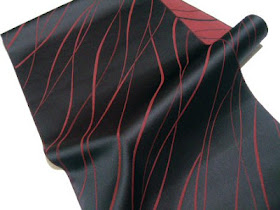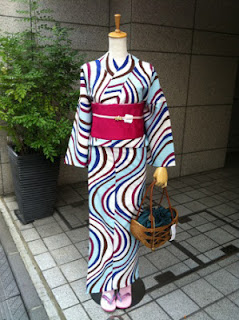A very Happy New Year, everyone! Here is the next installment in my mega-kimono motif translation series of this Japanese tea ceremony kimono site. Enjoy and feel free to ask if you have any questions! :)
(If you're looking to buy kimono, I recommend Rakuten for new ones, especially casual wear, and Ichiroya for nice vintage ones!)
for new ones, especially casual wear, and Ichiroya for nice vintage ones!)
(If you're looking to buy kimono, I recommend Rakuten
Unlined kimono (hitoe) and lightweight/gauze kimono
(usu-mono) are worn. Before the start of the rainy season, hitoe are worn.
After, kimono change to lightweight (meaning ro and such).
During midsummer, hemp kimono (asa) of high quality
plain-woven hemp cloth (joufu) are worn. Nowadays, they can be worn from the
beginning of July for the entire month.
Patterns include summer grasses, and water designs make us
think of coolness.
Colors such as refreshing white (shiro), dark blue (nou-kon) 010F29, light blue (mizu-iro) AFDFE4, and light gray (usu-nezumi) 9790A4 are preferred.
Colors such as refreshing white (shiro), dark blue (nou-kon) 010F29, light blue (mizu-iro) AFDFE4, and light gray (usu-nezumi) 9790A4 are preferred.
Obi
For material, ro and sha(1) are best suited. Colors are
white (shiro), black (kuro) (2), dark red (enji) B3424A, brown
(cha) 864A2B, green-tea green (matcha) B7BA6B, and light "wisteria" purple (fuji-iro) AFB4DB.
Because obi and kimono of this season share many of the same motifs like summer grasses and scenery, it’s stylish to pair a kimono and obi with related motifs. With plain color kimono, an obi dyed with blooming flowers is good for creating a sense of the season.
Accessories
Obi-age are things
like ro and mon-sha (a type of sha) silk in plain colors,
shibori-technique dye, or gradation, but they are worn tucked down into the obi
as much as possible. This is because seeing less of it than normal creates a
cooler feeling for the viewer.
Obi-jime are made of
transparent ra silk or finely braided cord (hoso-himo).
Naga-juban (underlayer
kimono) is made of lightweight material like ro, mon-sha, or asa.
 |
| Mon-sha naga-juban |
Notes (original author's)
When it comes to
naga-juban, ro type are used for ro kimono, sha type for sha kimono, and asa
type for asa kimono.
Colors
White, dark blue,
light blue, light purple (asa-murasaki) C4A3BF, off-white/cream (kinari) F6F5EA, black tea (kogecha) 6B493D. Transparent material made in dark colors
creates a feeling of coolness.
Patterns
Morning glory
(asa-gao), bellflower (hotaru-bukuro), “Hakusan burnet” (kara-ito-sou), summer
grasses (natsu-kusa), water lily (sui-ren), running water/streams (ryuu-sui),
waves (nami), and stylized snowflake (yuki-wa). As a note, yukiwa is also often
used just for its unique scallop-edge shape, which can be filled with other seasons’ flowers or
motifs.
 |
| Morning glory |
 | |||||
| Bellflower |
July Flowers
“Sunset hibiscus”
(ou-shoku-ki), “scarlet hibiscus”
(kou-shoku-ki), fringed orchid (sagi-sou), “Japanese bindweed” (hiru-gao),
bottle gourd (yuu-gao), pinks (nadeshi-ko), summer bush clover (natsu-hagi),
water lily (sui-ren), mizu-aoi (no English common name exists, but “water
mallow” or “water hollyhock” are the characters used), and Japanese pampas
grass (ito-susuki). Fall flowers can
also be used.
 |
| Fringed orchids |
 |
| Japanese bindweed |
 |
| Bottle gourd |
 |
| Pinks |
 |
| Summer bush clover |
See previous section for water lily
 |
| "mizu-aoi" (water hollyhock) |
Waves, flowing water/streams,
boats (fune), bridges (hashi), paper wishes (of the Tanabata festival)
(tanzaku)(3), bobbins (ito-maki)
See previous section for waves and flowing water
 |
| Boats |
 |
| Bridges |
“Midsummer kimono”: Ro
kimono are the norm for July kimono. The material called “ro” is woven with
stronger, finer threads than normal chirimen silk. This allows it to be woven
with lines of weave left open, making it transparent.
 |
| Kasuri technique |
Outside of ro, things
like sha and natsu-yuuki (summer version of famous fabrics woven in Yuki City) exist,
but these are textiles dyed before weaving. While these are generally said to
be unsuitable for tea ceremony, if one restricts oneself to plain-color kimono
with no “weft ikat” (kasuri) patterns there are cases where this is seen.
When it comes to
colors such as light "water" blue (mizu-asa-gi) 70A19F, pale purple (usu-murasaki) A3729A,
and silver-gray (kin-nezu) A1A3A6, pairing a kimono with an obi of a similar shade of that color or one with
a white background makes a harmonious pairing and one of coolness.
During a hot summer, it’s easy to go crazy with plain-weave hemp fabrics like Echigo, Miyako, and Noto(5), but due to their “weft-ikat” nature, they are unsuitable for tea ceremony. However, if you look for dyed hemp fabrics, you can find some nice ones. Paired with lightweight obi like dyed-pattern hemp obi, woven hemp “hassun” style obi(6), or ra silk fukuro obi, these kimono will look light and breezy.
 |
| Hassun obi |
Undergarments made of hemp are also best. Having a smooth-feeling Ojiya hemp or ro one will make it easier to get through the hottest days of summer.
Translator Footnotes
 |
| A bolt of Ojiya hemp fabric. |
(2) Solid-black fabrics or black-on-black patterned fabrics are reserved for “mofuku” (mourning wear) outfits. With July outfits make sure there is another color mixed in.
(3) Tanzaku can refer
to the actual paper wishes or just the tanzaku’s oblong rectangular shape, and
like “yukiwa” when used as a shape it is often filled with different motifs of
different seasons.
(4) These are all
different formality types of kimono. The point the author is making is that
anything formal, semi-formal or even just dyed-pattern rather than
woven-pattern needs to be ro silk.
(5) These are all
famous fabrics from big weaving areas in Japan. The Echigo area is in Niigata
Prefecture, Miyako comes from Miyakojima in Okinawa, and Noto comes from Shiga
Prefecture.
(6) Hassun obi, due to
their particular weave, have a visible darning or finishing stitch along the
edge of the obi.
 |
Translator Notes
- The firefly cuteness
continues from June! The Japanese word for bellflower is hotaru-bukuro, or
“firefly bag”.
- For woven pongee
(tsumugi) fabrics, Yuki (technically Yuuki) is one of the most famous and expensive types due to
its high quality, another being Oshima. I was lucky enough to get to handle
some of both at a recent kimono class seminar: lovely, lovely fabrics!
- Generally speaking,
fabrics dyed before being woven into a bolt of fabric are considered more
casual than those dyed afterward.
(Notes below repeated from previous months)
(Notes below repeated from previous months)
-The original author repeats several points, so with certain
common terms I am using the Japanese name on first mention only. If you’re
unsure of something, feel free to ask and I can clarify.
-The number next to the color name is that color's hex code as used in HTML. Keep in mind the exact shade may vary as well, from what I've seen cross-checking traditional color-name sites with actual kimono vendors.
-The number next to the color name is that color's hex code as used in HTML. Keep in mind the exact shade may vary as well, from what I've seen cross-checking traditional color-name sites with actual kimono vendors.
- As a note, this is a translation of a tea ceremony kimono
site. The tea ceremony world, I have learned, is among the strictest when it
comes to following proper seasonality rules, so bear in mind that these rules
are more stringent than the general thinking for daily and casual kimono
wearers.
It’s great if a daily wearer can put together an outfit following all of these rules, but very few will look at you funny if you can’t, as it’s hard and can be expensive to collect all the proper pieces. I’m translating this site more as part of my efforts to add to the world of English-language kimono information for those who don’t speak Japanese.
It’s great if a daily wearer can put together an outfit following all of these rules, but very few will look at you funny if you can’t, as it’s hard and can be expensive to collect all the proper pieces. I’m translating this site more as part of my efforts to add to the world of English-language kimono information for those who don’t speak Japanese.












































Thank you so much for taking time and effort to do this series of posts! For a non-japanese speaker but deep admiror of traditional kitsuke and kimono seasonality like me, these wonderfully explained and illustrated informations are pure gold! ^_^
ReplyDeleteCheers and thanks again!
Mai
You're very welcome and thank you for your comment! There's really not a lot like this in English, so I'm glad to help spread the kimono love. :D
ReplyDelete